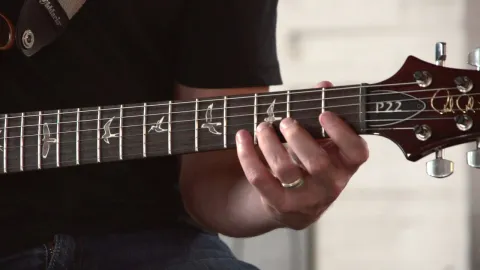Technique 101 - Finger Exercises

Let's talk about the pick. Some people resist using a pick, but I recommend that you use one. Picks are made out of different materials and come in many thicknesses. Please don't get a metal pick or anything crazy. Start with a normal celluloid or tortex medium thickness pick. As you progress, you might find that you want something a little different, but that will come naturally.
The pick should be held between the thumb and index finger so that the point of the pick is parallel with the strings. There should be no tension in your picking hand, wrist or arm. It is very important to relax. When you pick, the motion should come from the wrist and hand. Not the shoulder or elbow! You will get exhausted if you do this. Also, make sure that you are sitting up straight when you are playing. Hunching over is bad for your neck and back and can lead to injuries over time.
Now it is time to get you playing. Playing guitar is all about repetition and muscle memory. The best way to start is to work on finger exercises that will build up strength and dexterity in your finger muscles, as well as, build your hand-eye coordination. These are just exercises, like running a lap in gym class, and have no harmonic value.
We have four fingers at our disposal:
- 1 - Index
- 2 - Middle
- 3 - Ring
- 4 - Pinkie
To begin, take your first finger and put it behind the first fret on the sixth string. Pick that note with a downstroke. The best sound will be achieved when the finger is directly behind the fret and pushed down with moderate force. Do not squeeze the life out of it! Next, place your second finger behind the second fret of the same string and pick with an upstroke. Then, pick the third fret with the third finger using a downstroke. Lastly, pick the fourth fret with the fourth finger using an upstroke. Continue this exercise on each of the remaining five strings. When finished, your fourth finger should be on the fourth fret of the first string.
Now that we have taken this pattern forwards, we need to take it backwards. Slide your fourth finger up one fret to the fifth fret on the first string and play it with a downstroke. Then, with an upstroke play the third finger on the fourth fret of the same string. Next, play the third fret with your second finger with a downstroke. Lastly, pick the second fret on the first string with your first finger using an upstroke.
Continue this across the remaining five strings. You should end up on the second fret of the sixth string with your first finger. Once you are there, slide your first finger up one fret to the third fret and follow the forward pattern of this series over to the first string. Then, slide up one fret with your fourth finger on the first string and continue the backwards pattern of this series back to the sixth string. You get the idea. Follow this pattern all the way up to the twelfth fret. When done correctly, the last note played will be with your fourth finger on the first string on the twelfth fret.
This exercise should be done slow and steady, preferably to a metronome to ensure that you don't speed up. You want to make sure the notes ring out, sound clean, and are not rushed or chopped off. Accuracy, not speed, is the goal here. Once you can play this exercise accurately and cleanly at a slow tempo, gradually increase your tempo. Also, feel free to experiment and make up your own finger exercises. Try skipping strings and frets.